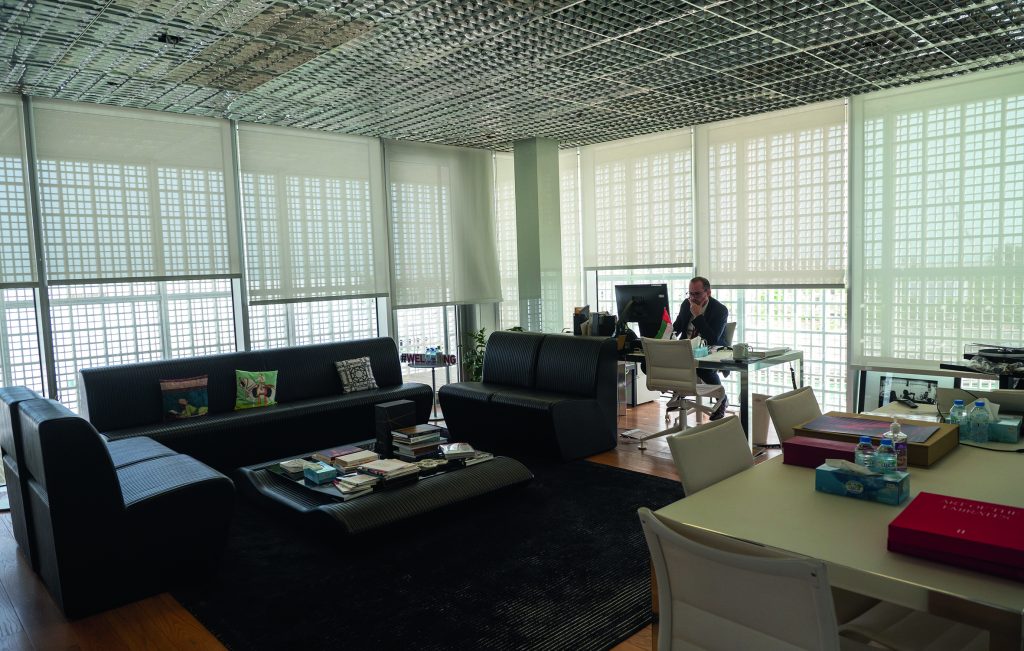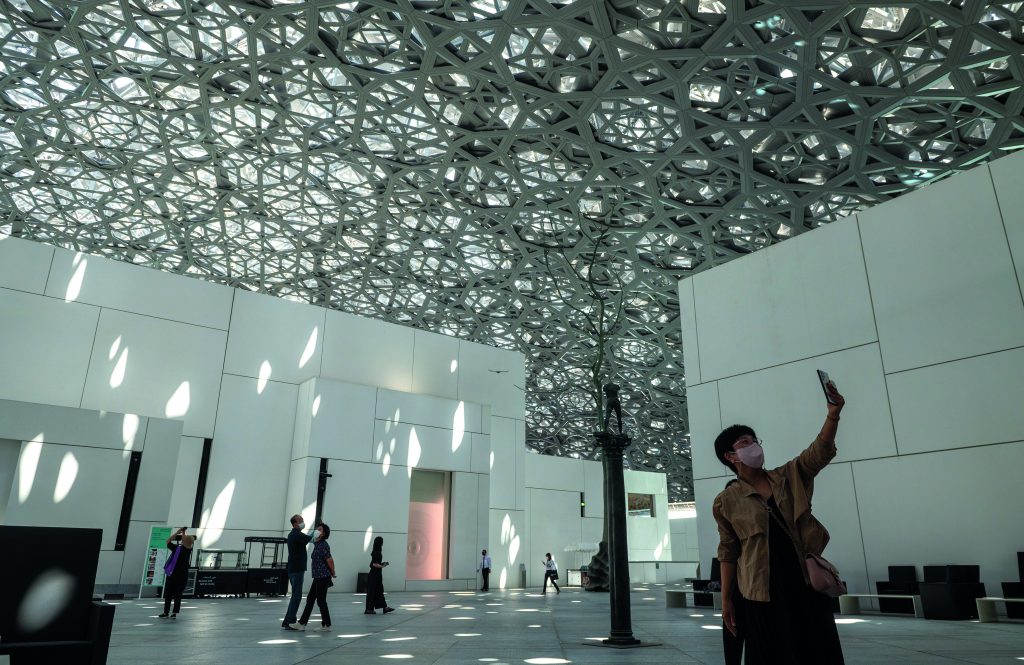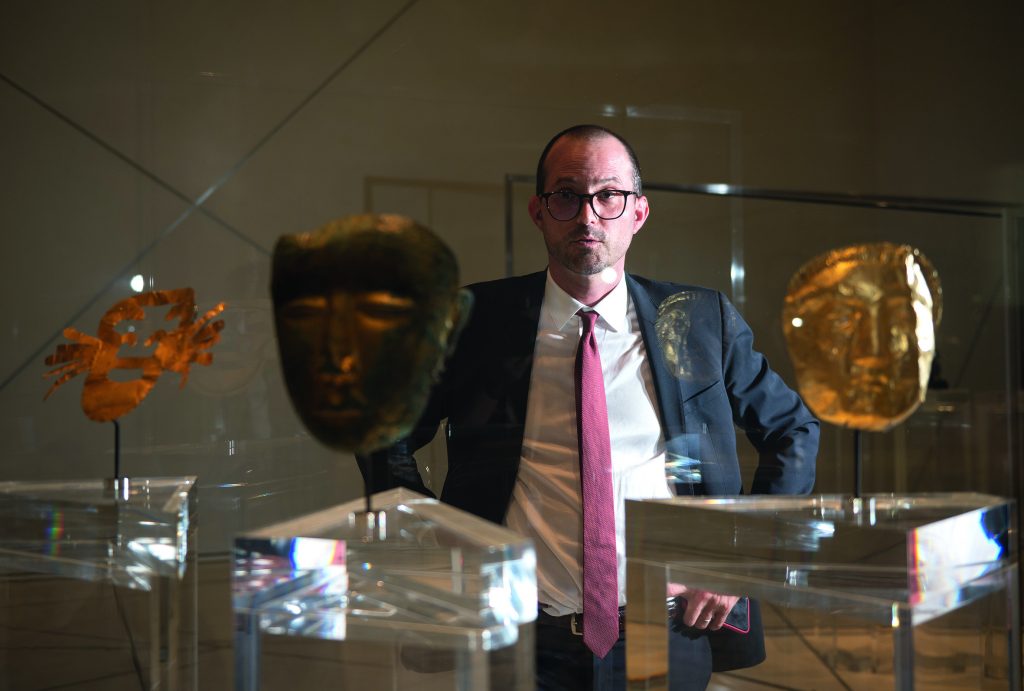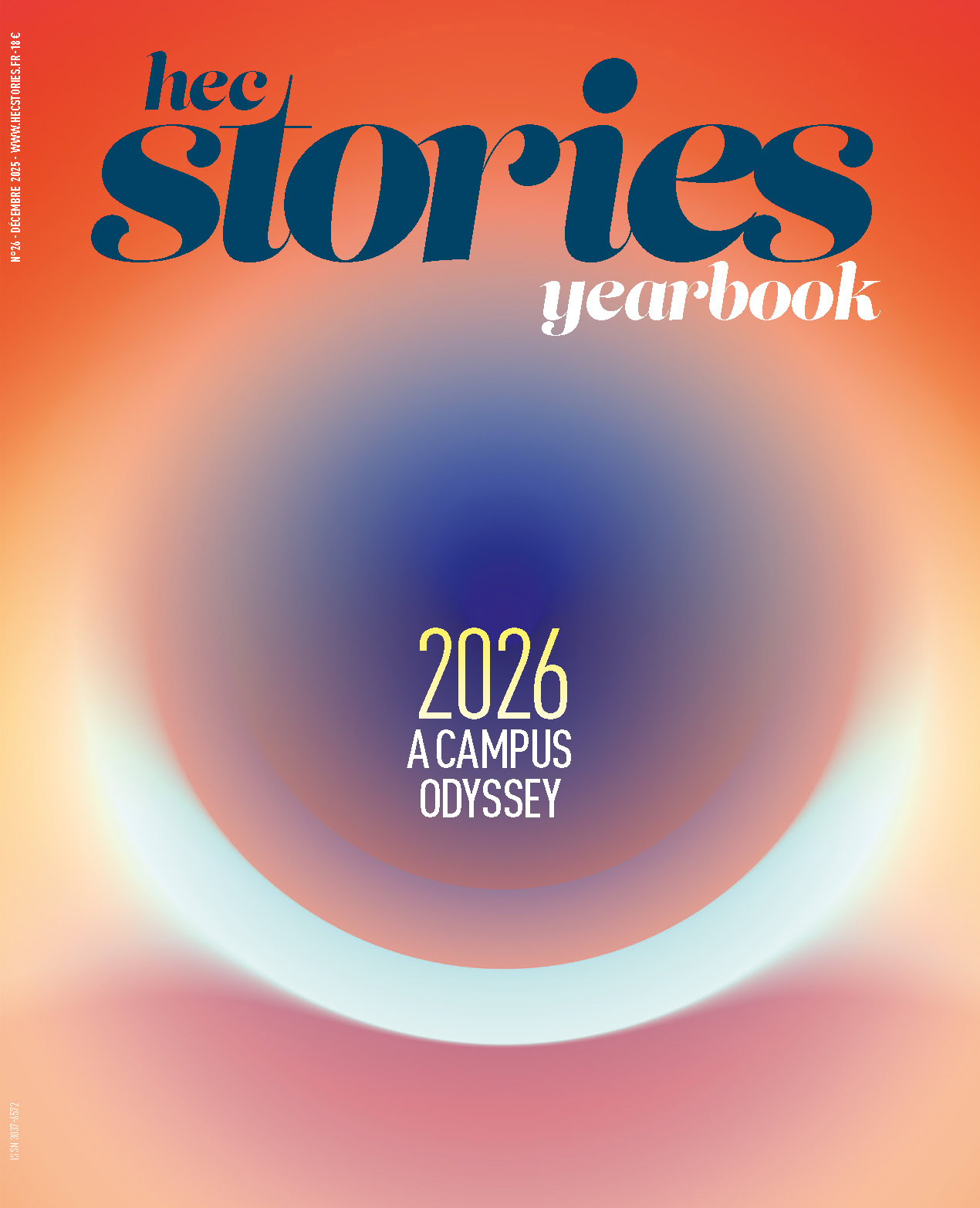Manuel Rabaté (H.01): 24 hours at the Louvre Abu Dhabi

Appointed director of the Louvre Abu Dhabi in 2016, Manuel Rabaté (H.01) is at the head of the first universal museum in the Arab world. We meet the man who wants to take the ambitious Franco-Emirati project to new horizons.
It is without doubt the most iconic achievement of architect Jean Nouvel. Set on the water like an island, the immense metal dome of the Louvre Abu Dhabi (LAD) stands out in a landscape dotted with cranes. The constructions devour the sand all around, raising a veil of white dust that envelops the museum like a cloud. It is 27°C on this late April morning. The sky is white, and the sun is blazing. Temperatures here will soon reach 50°C, with a humidity level of 90%. The weather is still good.
We are on Saadiyat Island, in the rapidly developing federal capital of the Emirates. The area is already home to the New York University Abu Dhabi and some luxury hotels. Soon three more museums will be built, as well as the House of Abraham, where a church, a synagogue and a mosque will be combined in the same square. Heavy as a suit of armour, the door of the Louvre Abu Dhabi opens to a uniformed guard checking that the AlHosn application is green. Up-to-date vaccinations and a negative PCR test are our passport. We head for the administration building, on the right wing of the museum. In this rectangular two-storey block, covered by a moucharabieh, is the office of the director, Manuel Rabaté (H.01). This 46-year-old Dijon native with a passion for the humanities, who was raised in a family divided between literature and science, has been running the museum since its opening in 2017. He trained at the Louvre in Paris, then his thirst for discovery and openness to others led him to work on the opening of the Quai Branly Museum. There, he met Hélène Fulgence (H.87), director of the cultural and exhibition department, and became her assistant. This is how he became associated with the Louvre Abu Dhabi project, which was completed in 2008.
10h. Management Office
Here, everything is bright and uncluttered. At the end of a long wooden corridor with glass windows, the director’s office is strewn with art books, paintings, statuettes, and other trophies. On a shelf is a large portrait of Sheikh Zayed, the founding father of the United Arab Emirates, which he led from its creation in 1971 until his death in November 2004. A coffee boy brings the coffee. In a navy-blue suit, white shirt and Burgundy tie, the manager, a dark-haired, bespectacled man with an elongated figure, welcomes us warmly. His day began an hour earlier with a strategic video conference. « We regularly check in with the heads of the other future Saadiyat museums to explore synergies, » he explains. We won’t know more; the coffee is getting cold. Manuel is a great consumer, but during Ramadan, the ritual becomes rarer. « I do half a Ramadan, I hardly eat, I drink a few coffees and a little water. We live in a community with a Muslim majority that is respectful and tolerant. They have no problem with you going to lunch or not, it’s just that the rhythm is spontaneously different. In the morning it’s busy, in the afternoon it’s quiet, and it starts again in the evening after iftar.

Indeed, that morning, Manuel had less than an hour to sift through the museum’s 2022-2026 master plan. A 180-page document that details the post-Covid strategy, vision, and ambitions of the Louvre Abu Dhabi. This is the fifth version of the document, and Manuel is still not satisfied. Opposite him, Mohamed Al Musharakh, marketing manager, is dutifully taking notes. A graduate in graphic design and multimedia from the University of Sharjah, this 22-year-old Emirati has been in the job for four months. He has already worked in the health, higher education, and nuclear sectors. Manuel moves fast, no detail escapes him. The message must be clear, interesting, and fun, » he says. This document will be addressed to our partners here and in France. We want to present our values, show that we are a universal museum, open and accessible to all audiences. Through our collections and temporary exhibitions, our performances, and conferences, as well as our research programmes, we are telling the story of art and of humanity.
After its inauguration, the Louvre Abu Dhabi experienced a two-year boom, with 1 million visitors per year. « We were starting to think about Louvre Abu Dhabi 2.0, which we saw as a place of education and research. But Covid forced us to put some projects on hold. The two years that followed were difficult. We have been in a recovery phase for a year now and we recently passed the 3 million visitor mark. Now we must give the museum a second wind: we have invested in a laboratory, which is still under construction, and we are going to develop training and research programmes, » he says. Manuel looks at his watch, it says 10:45. He exclaims in a hurry: « We have to get to the next meeting!
10h50. Dome and galleries
« Once a month I tour the museum with my technical staff, » says Manuel, accompanied by an Emirati and an Englishman from the operations department. As we pass under the dome of the museum, we come across a group of Asian tourists. The wonderment is visible. Manuel turns around and gives us a small smile, a sign of a successful mission. Supported by four hidden pillars, the massive steel dome (180 m in diameter and 7,500 t, as heavy as the Eiffel Tower) seems to float in the air and changes in the evening into a starry sky thanks to a clever play of lights. This outdoor space surrounded by the sea is home to works by contemporary artists such as Giuseppe Penone and Jenny Holzer. The place is peaceful, you can hear the birds singing. « The museum is a place of meaning. You can meditate under the dome, but also try to understand, to question deeply. I would like the museum to be open until midnight every night. The galleries would still close at 6.30 p.m., but the space under the dome would remain open, » he muses dreamily.
In the galleries, a constantly changing collection of several hundred works is displayed. Regional and international loans (especially from French museums, with which the museum has concluded an agreement) further enhance the exhibitions. « For a long time, we exhibited Leonardo da Vinci’s La Belle Ferronnière from the Louvre in Paris, or Bonaparte Crossing the Great St Bernard, a portrait of Napoleon on horseback by Jacques-Louis David. The public loved them, » recalls the director. This winter, it received masterpieces from the Musée d’Orsay and the Bibliothèque nationale de France. Visitors can now admire three works by Claude Monet. « But the number of loans is decreasing. At present, there are about 250 pieces on loan. The museum has also made some prestigious acquisitions, including a rare painting by the French Baroque painter Georges de La Tour, La Fillette au brasier (17th century), which is said to have sold for nearly 4 million euros, and a poignant work by Marc Chagall, Entre chien et loup. Through their eclecticism, the works highlight the influences, differences and commonalities of civilisations and eras. From Buddha heads to dancing Shiva, sarcophagi, a marvellous statuette of a Bactrian princess, armour, furniture, carpets, coins, photographs, and books reveal multiple facets of human history to the visitor. « Our collection is growing, and we still have to add to it, » Manuel says simply.

11h15. Environmental issues
Under the dome, in front of the Leaf of Light, a masterful tree sculpture by the Italian arte povera artist Giuseppe Penone, Manuel welcomes a group of experts from the Abu Dhabi Environmental Agency, who have come to study the possibility of introducing turtles into the pools adjacent to the museum. « Construction and human activity are reducing the living space for many species, » explains one of the experts. The seawater pools could help reintroduce the animals into their natural habitat, but it must be ensured that the turtles do not suffer from human proximity. « Wildlife is part of the cultural heritage and the visitor experience, » says the museum director.
14h45. Eid and birthday
We meet Manuel Rabaté in the auditorium for an update on the preparations for Eid-ul-Fitr. The festival that marks the end of Ramadan will be celebrated for a whole week. The Abu Dhabi Museum is planning film screenings and performances for the occasion. We are also planning the fifth anniversary of the Louvre Abu Dhabi, which will take place in November, » says its director. We will be doing a live duplex with Paris. In the meantime, one of the screens is no longer working and will have to be replaced.
15h. Meeting place
On the way back to the office, we meet Soraya Noujaim, the scientific director in charge of curating and managing the museum’s collections. She is accompanying Sir Antony Gormley, a British archaeologist, anthropologist, art historian and sculptor, considered one of the greatest contemporary artists. Manuel had lunch with him today. Artists, stars, politicians, businessmen, Manuel receives many of them. « My role is to be an ambassador for the museum, to promote it locally and internationally, by giving conferences or welcoming personalities. There is a lot of diplomatic and political activity in the Emirates, so we have many official delegations. In general, visitors are touched by the building and the collection and often find something that resonates with their culture or religion. Recent stars to have visited the museum include Tom Cruise, Frenchman Pierre Morel (director of Taken), Chinese pianist Lang Lang and French DJ David Guetta, who recorded a digital concert at the Louvre Abu Dhabi. Mixing electronic music and projections of the museum’s works, the concert was broadcast on social networks on 31 December. A hit.
16h30. Photo session
After a Teams recruitment interview with a French museum curator, Manuel takes a few minutes for a photo session. A precious time to get to know this discreet man. After studying at the Hypokhâgne, Sciences Po Paris and HEC, Manuel was able to make the most of three complementary courses. « All this has given me skills of synthesis and analysis and has enabled me not to be afraid of making decisions. I am capable of handling both ideas and quantitative data. HEC has enabled me to put leadership techniques at the service of my interest in culture, » he says, posing for the camera. An exhibition enthusiast, Manuel has refined his knowledge through reading and additional training, such as the Rachel Boyer course at the École du Louvre.

21h30. Rohaniyaat and VIP
Still 29°C outside. Manuel Rabaté is back at the museum for the Night of Poetry organised as part of the Ramadan Nights. Jean Nouvel’s sky lights up for the public. « It’s a privilege to be at the museum at this time of day, the atmosphere is very intimate, » observes Manuel, swept away by the softness of the place. At the entrance, coffee with cardamom and dates are served. The evening, entitled « Rohaniyaat » (spirituality in Arabic), is devoted to poetry readings. « We organised this event in partnership with the Arabic Language Center. It is a celebration of Ramadan and spirituality, the essence of the holy month, » says Alia bin Musabeh Al Shamsi, head of cultural programmes at Louvre Abu Dhabi. Among the VIPs who attended the reading were Snow Li, a founding member of the Louvre Abu Dhabi patrons, Ketevan Bochorishvili, former deputy minister of the economy of Georgia, and Wynton Harvey, model, photographer, and son of American comedian Steve Harvey. In front of a small audience, Manuel opened the evening by welcoming the poets.
22h45. In the lounge
The evening ends on the terrace of the Art Lounge, where the prestigious guests meet up with Manuel’s wife Mathilde and Nathalie Suleiman, head of individual sponsorship. The place mixes local and western influences. Seated on black and white sofas, this small crowd orders fruit juice, champagne, or wine. Manuel orders an Italian beer and gets to know his American guest who has opted for a local outfit: gandoura, long beige tunic and keffiyeh on his head. The discussion is friendly and should strengthen the ties with the museum’s patrons. The museum is funded by the Abu Dhabi government, not the federal government. But our bosses expect us to have some independence and other sources of funding, » says Manuel. In the past, up to two-thirds of our income came from ticket sales. With the pandemic, we lost a lot of revenue. We kept some partners and expanded our circle of patrons. We make some money from the shop and the restaurant, but we need to diversify. Ketevan Bochorishvili would like to introduce him to the head of Georgia’s museums, who is also an archaeologist and anthropologist.
It’s a good thing Manuel is planning a trip to Georgia in a few days. « Perhaps we can also organise a visit to an artist’s studio, » she suggests. Interested, Manuel asks the former minister about the functioning of museums and the country’s cultural influences. Partnerships with international museums allow the public to discover exceptional pieces from all over the world. Jordan brought to Abu Dhabi one of the oldest statues in the world, of which the director is very proud, the two-headed statue of Ain Ghazal, which dates to about 6,500 BC.
« It’s a difficult job that links politics, cultural policy, diplomacy and welcoming the public. The museum’s scientific purpose is extremely ambitious: we have just opened a documentation centre and wish to develop research on humanity and connected art. We are amid a daring experiment, with means that are not infinite, even if they are quite substantial. What is happening here is quite unique, it is part of the overall transformation of Abu Dhabi within the United Arab Emirates.
Published by La rédaction

